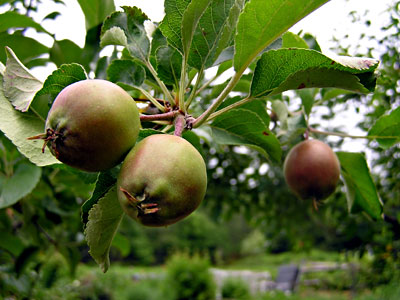 |
| When fruits aren’t thinned, a tree will produce many small apples rather than fewer, larger fruits. English photo. |
Summer Tasks
By C. J. Walke
As spring rolls into summer, I hope you’ve had a beautifully blooming, successfully pollinated orchard and avoided those late spring frosts that can kill blossoms and ruin your hopes for a satisfying harvest come fall. A temperature of 28 F is cold enough to kill an estimated 10 percent of apple blossoms, while 25 F will kill 90 percent of blossoms. As we experience more erratic weather patterns, these late frosts are becoming a concern for fruit and vegetable growers alike, requiring additional precautions. Assuming this has all passed, focus now on your young pea-size fruitlets to improve fruit development and manage pests that are in full swing and ready to reproduce.
Thinning to Improve Fruit Size
Have you seen an apple tree that’s produced loads of fruit, but they’re only the size of golf balls? Did you wonder why they didn’t grow any larger? Essentially, the tree has a limited amount of energy to put into growing the fruit, so with more fruitlets present, less energy is available for each fruitlet. This is where fruit thinning comes into play: Young fruitlets are intentionally removed from the tree to increase the amount of energy available to the remaining fruitlets. Conventional and IPM (integrated pest management) orchardists apply sprays to remove a percentage of the fruit through chemical means. Organic orchards do not have a similar spray material to thin fruit, so hand thinning is common.
Fruit thinning must be completed within the 35 to 40 days following petal fall. Thinning after the 40-day window tends not to increase fruit size, and usually the fruitlets remaining after the 40-day mark are more strongly attached and harder to break off.
Thinning also improves air circulation around the fruit to reduce the length of time leaves are wet and can support fungal diseases; it reduces hiding places for pests that prefer shelter while nibbling on your apples; and the reduced weight helps avoid broken branches, especially on peach trees. Thinning also helps reduce biennial bearing in varieties such as ‘Baldwin’ and ‘Honeycrisp,’ which are prone to this habit and can stand a bit more aggressive thinning.
The goal of thinning is to leave the strongest or biggest fruitlet in each cluster and to remove the rest, while spacing out the remaining fruit 6 to 8 inches along the branch. The king blossom in the center of the cluster is usually the largest of the bunch, since it is the first to open during bloom and subsequently the first to be pollinated and begin growth. Fruitlets tend to break off easily when they’re just bent over or even twisted. Be sure to remove the small stem and not just the fruitlet.
Thinning is time consuming but can be a fun family activity or cause for friendly gatherings to make your fruit growing a community event.
June Drop and Pest Control
While thinning, scout for early pest damage to young fruitlets. You may find damage from European apple sawfly or plum curculio. Sawfly damage will show a small winding scar on the fruit surface, and plum curculio leaves a crescent scar, while both can also make small punctures that ooze fruit juices. (See the March-May 2011 MOF&G for a photo of sawfly damage.) Remove these damaged fruitlets and disposed of them properly. Because pest larvae may inhabit a fruitlet without leaving clear signs, collect all thinned fruit in buckets and destroy them, preferably by feeding them to livestock.
“June drop” is the period when damaged, poorly pollinated or larvae-riddled fruit drop from the tree. Internal fruit-feeding pests tend to go straight to the highly nutritional seeds and consume them, so the tree will abscise these fruitlets since they are not viable for reproduction. When the fruitlet drops to the ground, the larvae exit the fruit to pupate into adults and return to lay more eggs and damage more fruit. Collecting drops two or three times a week and disposing of them will help reduce second generation pest populations – often the generation that damages fruit most at harvest. Observing the orchard frequently helps identify issues before they get out of control, especially in no-spray or low-spray backyard orchards.
C.J. Walke is MOFGA’s development associate, librarian and organic orchardist. You can address your orcharding questions to him at 568-4142 or [email protected].

